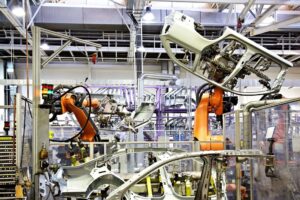Change is the only constant. And who better knows about it other than us humans. We have a very peculiar manner of adopting a change. We first resist it, fight it, try our best to avoid becoming part of it, get tired and finally adopt it. For some it is a good change and for some, it isn’t. That’s the way it is. Same goes for an ERP Change Management process within a Small & Medium manufacturing enterprise where it is a very tricky process.
They already face numerous challenges such as operating on wafer-thin margins, rushing to reduce production & labor costs, material wastage, struggling to procure inventory on time and meeting delivery deadlines. To resolve this, they opt for an ERP solution that fits their business needs. But an ERP implementation means Change.
A new ERP system can mean long-term structural transformation, a permanent and significant impact on virtually every business function, work-flow, process and department across the enterprise.
In addition to these, the biggest impact falls on the human element as manual processes are automated, long-running processes under each department gets eliminated or drastically modified. All this impacts the employee and his role within the organization. The employee is suddenly gets insecure because of these rapid changes and starts having a doubt on his job-role, capability and job-security.
Every action comes with an equal or opposite reaction. And with Change comes an even more fierce reaction – Resistance to Change which can single-handedly determine the success or failure of the ERP implementation.
Steps to Ease Resistance to Change
Considering all these issues, there is an immediate need to address the numerous insecurities and make employees, a definite part of an ERP implementation.
Considering you have,
- Identified your organizational problems, scope for improvement.
- Analyzed your existing Key Performance Indicators (KPIs), objectives, business processes, workflows etc.
- Evaluated various ERP software
- Evaluated your Data Migration and Infrastructure readiness
- Evaluated the need for customization
- Zeroed in on the best-fit and signed a deal with the ERP vendor
Congratulations!
You have taken the first step towards greater efficiency and profitability of your organization. However, there is a fire path that you need to cross and that is Change Management.
Let us take you through the steps that will ease out your efforts in making this change successful.
Identify the Most Affected

The first step is identifying personnel who will be impacted by this change the most. These personnel would be handling tasks in the shop-floor, assembly-line, procurement department, accounts department etc. and the ERP implementation might hit their day-to-day tasks the most. Identifying them and collating their existing job-role, tasks they handle and outlining their new role/task post implementation will drastically decrease their resistance to change.
Constant Communication

The second most important step is to communicate with them. Not once, not twice but constantly. A continuous engagement throughout the implementation works wonders and they not only feel welcomed into the change but also feel that they are an integral & important part of the organization.
In this process, they are made to understand why the organization needs an ERP and how will it benefit the employees first and later the organization. They need to be made to understand that ERP automation will not affect their jobs but give them an opportunity to learn something new, become more productive, efficient and improve their careers.
Also, there would be definite cases where an employee would be non-cooperative and complaining, not attend key meetings or not provide key information or resources that would be required for the implementation. In such cases, going into the bottom of the behavior would help zero in on the exact reason with the help of a meaningful conversation.
Involve Employees in ERP Implementation

Your employees are the best experts when it comes to workflow and business processes as they have worked day in and day out and are capable to provide useful insights. Make them a part of this implementation. This will bolster their confidence and also give them a sense of importance and on a common mission towards achieving a successful ERP implementation.
Also, the team should be led by a capable senior executive or manager who not only understands the requirements thoroughly and solves organizational and technical hurdles, but also employee sentiments and the sensitivity of the entire process. This greatly improves the odds of a successful implementation.
Personnel Training

There are instances when employees are not tech-savvy and find it difficult to understand the entire concept of an ERP and why it is getting implemented in the first place. Moreover, during the communication and engagement stage, they are overwhelmed with the huge amount of information given to them and just switch off for the rest of the part. This proves to be counterproductive and you might lose out on a good resource whose inputs might be critical.
To tackle this, adequate training should be provided to such employees. Apart from the general information about the ERP and its associated technology, they should be taught the new way of operating their respective operations and processes. Other employees who are tech-savvy can be roped in to create quality training content to seamlessly train others and hand-hold them.
In a nutshell, every employee who might get affected needs to be adequately trained on the new way of operations, ERP and associated technology. There should be mockup operations where they actually get a hands-on approach that will highlight the need to improve their skills considerably.
Monitoring and Improvement

An ERP implementation is time-bound and cannot afford any slip-ups or hurdle. Continuous monitoring of implementation phases, employee behavior, change results etc. helps in proactive detection of issues and its immediate fix before it blows up into a full-fledged problem.
Conclusion
The Human factor is always going to be a critical factor in any form of change within the organization. It involves dealing with emotions, aspirations, survival, current & future-state of the person working with you. For the organization, he might be just a single employee/resource but for him, it is the question of surviving the odds for himself and his family and any form of change can threaten their well-being.
Although not-intentional but sometimes organizations can unknowingly send wrong signals through their communications which will increase the resistance to change that they are bringing in. Therefore, it has to be dealt with properly to ensure a successful ERP implementation and happy employees.







5 Responses
Just exploring your services
Non ut quae sit expedita adipisicing minima amet facilis possimus et quae nihil
Omnis deserunt ullam exercitationem temporibus
Voluptas quam Nam quis omnis eveniet voluptatem Doloribus dolore doloremque facilis voluptatem Quis veniam labore accusamus et
Corporis dolorem exercitationem quia neque obcaecati quo sed autem dolor